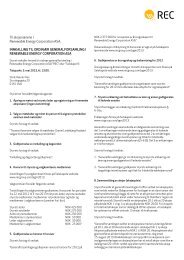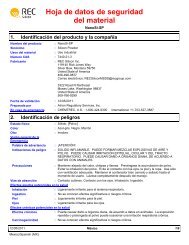[PDF] MONOCHLOROSILANE_RSD ISS MSDS North America - REC
[PDF] MONOCHLOROSILANE_RSD ISS MSDS North America - REC
[PDF] MONOCHLOROSILANE_RSD ISS MSDS North America - REC
- TAGS
- msds
- america
- www.recgroup.com
Create successful ePaper yourself
Turn your PDF publications into a flip-book with our unique Google optimized e-Paper software.
1.<br />
Product name<br />
Synonym<br />
<strong>MONOCHLOROSILANE</strong><br />
MCS<br />
Material uses<br />
: Not available.<br />
CAS number : 13465-78-6<br />
Manufacturer<br />
Prepared by<br />
In case of emergency<br />
2.<br />
Material Safety Data Sheet<br />
<strong>MONOCHLOROSILANE</strong><br />
Product and company identification<br />
Hazards identification<br />
:<br />
:<br />
:<br />
:<br />
:<br />
<strong>REC</strong> Silicon Inc.<br />
119140 Rick Jones Way<br />
Silver Bow, Montana 59750<br />
United State of <strong>America</strong><br />
406-496-9877<br />
Email: <strong>REC</strong>Silicon<strong>MSDS</strong>@recgroup.com<br />
3322 Road N <strong>North</strong>east<br />
Moses Lake, Washington 98837<br />
United State of <strong>America</strong><br />
509-766-9299<br />
Physical state : Gas. [Liquefied gas]<br />
Color : Colorless.<br />
Odor : hydrochloric acid<br />
Emergency overview<br />
Routes of entry<br />
Potential acute health effects<br />
Inhalation<br />
Ingestion<br />
Skin<br />
Eyes<br />
:<br />
Atrion Regulatory Services, Inc.<br />
CHEMT<strong>REC</strong>, U.S. : 1-800-424-9300 International: +1-703-527-3887<br />
Signal word<br />
: DANGER!<br />
Hazard statements : FLAMMABLE GAS. MAY CAUSE FLASH FIRE. CAUSES RESPIRATORY TRACT,<br />
EYE AND SKIN BURNS. HARMFUL IF INHALED. MAY CAUSE TARGET ORGAN<br />
DAMAGE, BASED ON ANIMAL DATA.<br />
Precautions :<br />
Keep away from heat, sparks and flame. Do not breathe gas. Do not get in eyes or on<br />
skin or clothing. Use only with adequate ventilation. Keep container tightly closed and<br />
sealed until ready for use. Wash thoroughly after handling.<br />
Dermal contact. Eye contact. Inhalation.<br />
: Toxic by inhalation. Corrosive to the respiratory system.<br />
: May cause burns to mouth, throat and stomach. Ingestion of liquid can cause burns<br />
similar to frostbite.<br />
: Corrosive to the skin. Causes burns. Dermal contact with rapidly evaporating liquid<br />
could result in freezing of the tissues or frostbite.<br />
: Corrosive to eyes. Causes burns. Liquid can cause burns similar to frostbite.<br />
Potential chronic health effects<br />
Chronic effects : May cause target organ damage, based on animal data.<br />
Carcinogenicity : No known significant effects or critical hazards.<br />
Mutagenicity : No known significant effects or critical hazards.<br />
Teratogenicity :<br />
No known significant effects or critical hazards.<br />
Developmental effects : No known significant effects or critical hazards.<br />
05/24/2011.<br />
Canada/English (US)<br />
Canada<br />
1/9
<strong>MONOCHLOROSILANE</strong><br />
2.<br />
Hazards identification<br />
Fertility effects : No known significant effects or critical hazards.<br />
Target organs : May cause damage to the following organs: upper respiratory tract, skin, eyes.<br />
Over-exposure signs/symptoms<br />
Inhalation :<br />
Ingestion : Adverse symptoms may include the following:<br />
frostbite<br />
stomach pains<br />
Skin : Adverse symptoms may include the following:<br />
frostbite<br />
pain or irritation<br />
redness<br />
blistering may occur<br />
Eyes : Adverse symptoms may include the following:<br />
frostbite<br />
pain<br />
watering<br />
redness<br />
Medical conditions<br />
aggravated by overexposure<br />
3.<br />
:<br />
Adverse symptoms may include the following:<br />
respiratory tract irritation<br />
coughing<br />
Pre-existing disorders involving any target organs mentioned in this <strong>MSDS</strong> as being at<br />
risk may be aggravated by over-exposure to this product.<br />
Composition/information on ingredients<br />
Name CAS number %<br />
chlorosilane 13465-78-6 60-100<br />
There are no additional ingredients present which, within the current knowledge of the supplier and in the<br />
concentrations applicable, are classified as hazardous to health or the environment and hence require reporting in<br />
this section.<br />
4.<br />
Eye contact<br />
Skin contact<br />
First aid measures<br />
:<br />
:<br />
Check for and remove any contact lenses. Immediately flush eyes with plenty of water<br />
for at least 15 minutes, occasionally lifting the upper and lower eyelids. Get medical<br />
attention immediately.<br />
In case of contact with liquid, warm frozen tissues slowly with lukewarm water. To avoid<br />
the risk of static discharges and gas ignition, soak contaminated clothing thoroughly with<br />
water before removing it. Wash clothing before reuse. Clean shoes thoroughly before<br />
reuse. Get medical attention immediately.<br />
Inhalation : Move exposed person to fresh air. If not breathing, if breathing is irregular or if<br />
respiratory arrest occurs, provide artificial respiration or oxygen by trained personnel.<br />
Loosen tight clothing such as a collar, tie, belt or waistband. Get medical attention<br />
immediately.<br />
Ingestion<br />
: As this product rapidly becomes a gas when released, refer to the inhalation section.<br />
Protection of first-aiders : No action shall be taken involving any personal risk or without suitable training. If it is<br />
suspected that fumes are still present, the rescuer should wear an appropriate mask or<br />
self-contained breathing apparatus. It may be dangerous to the person providing aid to<br />
give mouth-to-mouth resuscitation. Wash contaminated clothing thoroughly with water<br />
before removing it, or wear gloves.<br />
Antidote information<br />
05/24/2011.<br />
Canada/English (US)<br />
Canada<br />
2/9
<strong>MONOCHLOROSILANE</strong><br />
4.<br />
First aid measures<br />
Product/ingredient name Antidote information<br />
No antidote information known<br />
Notes to physician :<br />
5.<br />
Fire-fighting measures<br />
Flammability of the product :<br />
Extinguishing media<br />
Suitable :<br />
Not suitable :<br />
Special exposure hazards :<br />
Hazardous thermal<br />
decomposition products<br />
Special protective<br />
equipment for fire-fighters<br />
6.<br />
:<br />
No specific treatment. Treat symptomatically. Contact poison treatment specialist<br />
immediately if large quantities have been ingested or inhaled.<br />
Contains gas under pressure. Flammable gas. In a fire or if heated, a pressure<br />
increase will occur and the container may burst, with the risk of a subsequent explosion.<br />
The vapor/gas is heavier than air and will spread along the ground. Gas may<br />
accumulate in low or confined areas or travel a considerable distance to a source of<br />
ignition and flash back, causing fire or explosion.<br />
Use an extinguishing agent suitable for the surrounding fire.<br />
Do not use water jet.<br />
Promptly isolate the scene by removing all persons from the vicinity of the incident if<br />
there is a fire. No action shall be taken involving any personal risk or without suitable<br />
training. Contact supplier immediately for specialist advice. Move containers from fire<br />
area if this can be done without risk. Use water spray to keep fire-exposed containers<br />
cool. If involved in fire, shut off flow immediately if it can be done without risk. If this is<br />
impossible, withdraw from area and allow fire to burn. Fight fire from protected location<br />
or maximum possible distance.<br />
: Decomposition products may include the following materials:<br />
halogenated compounds<br />
metal oxide/oxides<br />
hydrogen chloride<br />
hydrogen<br />
silicon (Oxide.)<br />
Accidental release measures<br />
Personal precautions :<br />
Environmental precautions<br />
Methods for cleaning up<br />
Small spill :<br />
Large spill :<br />
05/24/2011.<br />
Canada/English (US)<br />
Fire-fighters should wear appropriate protective equipment and self-contained breathing<br />
apparatus (SCBA) with a full face-piece operated in positive pressure mode. For<br />
incidents involving large quantities, thermally insulated undergarments and thick textile<br />
or leather gloves should be worn.<br />
Accidental releases pose a serious fire or explosion hazard. Immediately contact<br />
emergency personnel. No action shall be taken involving any personal risk or without<br />
suitable training. Evacuate surrounding areas. Keep unnecessary and unprotected<br />
personnel from entering. Do not touch or walk through spilled material. Shut off all<br />
ignition sources. No flares, smoking or flames in hazard area. Do not breathe gas.<br />
Provide adequate ventilation. Wear appropriate respirator when ventilation is<br />
inadequate. Put on appropriate personal protective equipment (see Section 8).<br />
: Ensure emergency procedures to deal with accidental gas releases are in place to avoid<br />
contamination of the environment. Avoid dispersal of spilled material and runoff and<br />
contact with soil, waterways, drains and sewers. Inform the relevant authorities if the<br />
product has caused environmental pollution (sewers, waterways, soil or air).<br />
Immediately contact emergency personnel. Stop leak if without risk. Use spark-proof<br />
tools and explosion-proof equipment.<br />
Immediately contact emergency personnel. Stop leak if without risk. Use spark-proof<br />
tools and explosion-proof equipment. Note: see section 1 for emergency contact<br />
information and section 13 for waste disposal.<br />
Canada<br />
3/9
<strong>MONOCHLOROSILANE</strong><br />
7.<br />
Handling<br />
Storage<br />
8.<br />
Handling and storage<br />
:<br />
:<br />
Put on appropriate personal protective equipment (see Section 8). Eating, drinking and<br />
smoking should be prohibited in areas where this material is handled, stored and<br />
processed. Workers should wash hands and face before eating, drinking and smoking.<br />
Remove contaminated clothing and protective equipment before entering eating areas.<br />
Contains gas under pressure. Do not get in eyes or on skin or clothing. Do not breathe<br />
gas. Use only with adequate ventilation. Wear appropriate respirator when ventilation is<br />
inadequate. Do not enter storage areas and confined spaces unless adequately<br />
ventilated. Store and use away from heat, sparks, open flame or any other ignition<br />
source. Use explosion-proof electrical (ventilating, lighting and material handling)<br />
equipment. Use non-sparking tools. Keep away from water or moist air. Empty<br />
containers retain product residue and can be hazardous. Do not puncture or incinerate<br />
container.<br />
Store in accordance with local regulations. Store in a segregated and approved area.<br />
Store in a dry, cool and well-ventilated area, away from incompatible materials (see<br />
Section 10). Eliminate all ignition sources. Keep away from water or moist air. Keep<br />
container tightly closed and sealed until ready for use.<br />
Exposure controls/personal protection<br />
Occupational exposure limits<br />
No exposure limit value known.<br />
Consult local authorities for acceptable exposure limits.<br />
Recommended monitoring<br />
procedures<br />
Engineering measures : Use only with adequate ventilation. Use process enclosures, local exhaust ventilation or<br />
other engineering controls to keep worker exposure to airborne contaminants below any<br />
recommended or statutory limits. The engineering controls also need to keep gas, vapor<br />
or dust concentrations below any lower explosive limits. Use explosion-proof ventilation<br />
equipment.<br />
Hygiene measures : Wash hands, forearms and face thoroughly after handling chemical products, before<br />
eating, smoking and using the lavatory and at the end of the working period. Appropriate<br />
techniques should be used to remove potentially contaminated clothing. Wash<br />
contaminated clothing before reusing. Ensure that eyewash stations and safety showers<br />
are close to the workstation location.<br />
Personal protection<br />
Respiratory<br />
Hands :<br />
Eyes<br />
Skin<br />
05/24/2011.<br />
Canada/English (US)<br />
: If this product contains ingredients with exposure limits, personal, workplace atmosphere<br />
or biological monitoring may be required to determine the effectiveness of the ventilation<br />
or other control measures and/or the necessity to use respiratory protective equipment.<br />
:<br />
:<br />
:<br />
Use a properly fitted, air-purifying or air-fed respirator complying with an approved<br />
standard if a risk assessment indicates this is necessary. Respirator selection must be<br />
based on known or anticipated exposure levels, the hazards of the product and the safe<br />
working limits of the selected respirator.<br />
Chemical-resistant, impervious gloves complying with an approved standard should be<br />
worn at all times when handling chemical products if a risk assessment indicates this is<br />
necessary. If contact with the liquid is possible, insulated gloves suitable for low<br />
temperatures should be worn. >8 hours (breakthrough time): Leather.<br />
Safety eyewear complying with an approved standard should be used when a risk<br />
assessment indicates this is necessary to avoid exposure to liquid splashes, mists or<br />
dusts. Recommended: full-face mask<br />
Personal protective equipment for the body should be selected based on the task being<br />
performed and the risks involved and should be approved by a specialist before handling<br />
this product.<br />
Canada<br />
4/9
<strong>MONOCHLOROSILANE</strong><br />
8.<br />
Exposure controls/personal protection<br />
Environmental exposure<br />
controls<br />
9.<br />
Physical state<br />
Color<br />
Odor<br />
Boiling/condensation point<br />
Melting/freezing point<br />
: Emissions from ventilation or work process equipment should be checked to ensure they<br />
comply with the requirements of environmental protection legislation. In some cases,<br />
fume scrubbers, filters or engineering modifications to the process equipment will be<br />
necessary to reduce emissions to acceptable levels.<br />
Physical and chemical properties<br />
Molecular weight<br />
Molecular formula<br />
pH<br />
Gas. [Liquefied gas]<br />
Colorless.<br />
hydrochloric acid<br />
66.56 g/mole<br />
ClH3Si<br />
Not available.<br />
-30.417°C (-22.8°F)<br />
-118°C (-180.4°F)<br />
Density : Not available.<br />
Vapor pressure<br />
: 16.7 kPa (125.3 mm Hg) [50°C]<br />
Vapor density<br />
Odor threshold<br />
Evaporation rate<br />
Viscosity<br />
Solubility<br />
2.3 [Air = 1]<br />
Not available.<br />
82 (butyl acetate = 1)<br />
Not available.<br />
Reacts violently with water.<br />
LogKow : Not available.<br />
Physical/chemical<br />
properties comments<br />
: Volatility (W/W (%)): 100%<br />
:<br />
Flash point : Closed cup: -90°C (-130°F) [Tagliabue.]<br />
Auto-ignition temperature : Not available.<br />
Flammable limits : Lower: 4.6 to 4.8%<br />
Upper: 94 to 98%<br />
10.<br />
Stability and reactivity<br />
Chemical stability<br />
Conditions to avoid<br />
Incompatible materials<br />
Hazardous decomposition<br />
products<br />
Possibility of hazardous<br />
reactions<br />
05/24/2011.<br />
Canada/English (US)<br />
:<br />
:<br />
:<br />
:<br />
:<br />
:<br />
:<br />
:<br />
:<br />
:<br />
:<br />
:<br />
:<br />
:<br />
:<br />
:<br />
The product is stable.<br />
Avoid all possible sources of ignition (spark or flame). Do not pressurize, cut, weld,<br />
braze, solder, drill, grind or expose containers to heat or sources of ignition. Do not<br />
allow gas to accumulate in low or confined areas.<br />
Reactive or incompatible with the following materials: oxidizing materials.<br />
Ammonia, water, air, alcohols, amines<br />
Under normal conditions of storage and use, hazardous decomposition products should<br />
not be produced.<br />
: Under normal conditions of storage and use, hazardous reactions will not occur.<br />
Under normal conditions of storage and use, hazardous polymerization will not occur.<br />
Canada<br />
5/9
<strong>MONOCHLOROSILANE</strong><br />
11.<br />
Toxicological information<br />
Acute toxicity<br />
Not available.<br />
Chronic toxicity<br />
Not available.<br />
Irritation/Corrosion<br />
Not available.<br />
Sensitizer<br />
Not available.<br />
Carcinogenicity<br />
Classification<br />
Not available.<br />
Mutagenicity<br />
Not available.<br />
Teratogenicity<br />
Not available.<br />
Reproductive toxicity<br />
Not available.<br />
12.<br />
Ecological information<br />
Ecotoxicity : No known significant effects or critical hazards.<br />
Aquatic ecotoxicity<br />
Not available.<br />
Persistence/degradability<br />
Not available.<br />
Partition coefficient: noctanol/water<br />
Mobility :<br />
Toxicity of the products of<br />
biodegradation<br />
:<br />
: Not available.<br />
Bioconcentration factor : Not available.<br />
Not available.<br />
Not available.<br />
Other adverse effects : No known significant effects or critical hazards.<br />
13.<br />
Disposal considerations<br />
Waste disposal<br />
05/24/2011.<br />
Canada/English (US)<br />
:<br />
The generation of waste should be avoided or minimized wherever possible. Significant<br />
quantities of waste product residues should not be disposed of via the foul sewer but<br />
processed in a suitable effluent treatment plant. Dispose of surplus and non-recyclable<br />
products via a licensed waste disposal contractor. Disposal of this product, solutions<br />
and any by-products should at all times comply with the requirements of environmental<br />
protection and waste disposal legislation and any regional local authority requirements.<br />
Empty pressure vessels should be returned to the supplier. Waste packaging should be<br />
recycled. Incineration or landfill should only be considered when recycling is not<br />
feasible. This material and its container must be disposed of in a safe way. Empty<br />
Canada<br />
6/9
<strong>MONOCHLOROSILANE</strong><br />
13.<br />
Disposal considerations<br />
containers or liners may retain some product residues. Do not puncture or incinerate<br />
container.<br />
Disposal should be in accordance with applicable regional, national and local laws and regulations.<br />
Refer to Section 7: HANDLING AND STORAGE and Section 8: EXPOSURE CONTROLS/PERSONAL PROTECTION<br />
for additional handling information and protection of employees.<br />
14.<br />
Regulatory<br />
information<br />
Transport information<br />
UN number Proper shipping<br />
name<br />
TDG Classification UN3309 LIQUEFIED GAS,<br />
TOXIC,<br />
FLAMMABLE,<br />
CORROSIVE, N.O.S.<br />
(chlorosilane)<br />
2.3 (8)<br />
IMDG Class UN3309 LIQUEFIED GAS,<br />
TOXIC,<br />
FLAMMABLE,<br />
CORROSIVE, N.O.S.<br />
(chlorosilane)<br />
2.3 (2.1, 8) -<br />
IATA-DGR Class UN3309 Liquefied gas, toxic,<br />
flammable, corrosive,<br />
n.o.s. (chlorosilane)<br />
2.3 (2.1, 8)<br />
PG* : Packing group<br />
05/24/2011.<br />
Canada/English (US)<br />
Canada<br />
Classes PG* Label Additional<br />
information<br />
-<br />
-<br />
Explosive Limit and<br />
Limited Quantity Index<br />
0<br />
ERAP Index<br />
0<br />
Passenger Carrying Ship<br />
Index<br />
Forbidden<br />
Passenger Carrying Road<br />
or Rail Index<br />
Forbidden<br />
Special provisions<br />
16, 38<br />
Emergency schedules<br />
(EmS)<br />
_F-D_, S-U<br />
Passenger and Cargo<br />
AircraftQuantity limitation:<br />
Forbidden<br />
Packaging instructions:<br />
Forbidden<br />
Cargo Aircraft OnlyQuantity<br />
limitation: Forbidden<br />
Packaging instructions:<br />
Forbidden<br />
Limited Quantities -<br />
Passenger AircraftQuantity<br />
limitation: Forbidden<br />
Packaging instructions:<br />
Forbidden<br />
7/9
<strong>MONOCHLOROSILANE</strong><br />
15.<br />
Regulatory information<br />
United States inventory<br />
(TSCA 8b)<br />
WHMIS (Canada) : Class B-6: Reactive flammable material<br />
Class D-1B: Material causing immediate and serious toxic effects (Toxic).<br />
Class E: Corrosive material<br />
Class F: Dangerously reactive material.<br />
Canadian lists<br />
Canadian NPRI : This material is not listed.<br />
CEPA Toxic substances : This material is not listed.<br />
Canada inventory : This material is not listed in DSL but is listed in NDSL.<br />
This product has been classified in accordance with the hazard criteria of the Controlled Products Regulations<br />
and the <strong>MSDS</strong> contains all the information required by the Controlled Products Regulations.<br />
International regulations<br />
International lists<br />
Chemical Weapons<br />
Convention List Schedule I<br />
Chemicals<br />
Chemical Weapons<br />
Convention List Schedule<br />
II Chemicals<br />
Chemical Weapons<br />
Convention List Schedule<br />
III Chemicals<br />
16.<br />
Other information<br />
Label requirements :<br />
Hazardous Material<br />
Information System (U.S.A.)<br />
Date of issue<br />
Date of previous issue<br />
:<br />
: This material is listed or exempted.<br />
:<br />
:<br />
:<br />
Australia inventory (AICS): Not determined.<br />
China inventory (IECSC): Not determined.<br />
Japan inventory: This material is listed or exempted.<br />
Korea inventory: This material is listed or exempted.<br />
New Zealand Inventory of Chemicals (NZIoC): Not determined.<br />
Philippines inventory (PICCS): Not determined.<br />
: Not listed<br />
: Not listed<br />
: Not listed<br />
Caution: HMIS® ratings are based on a 0-4 rating scale, with 0 representing minimal hazards or risks, and 4<br />
representing significant hazards or risks Although HMIS® ratings are not required on <strong>MSDS</strong>s under 29 CFR<br />
1910.1200, the preparer may choose to provide them. HMIS® ratings are to be used with a fully implemented<br />
HMIS® program. HMIS® is a registered mark of the National Paint & Coatings Association (NPCA). HMIS®<br />
materials may be purchased exclusively from J. J. Keller (800) 327-6868.<br />
The customer is responsible for determining the PPE code for this material.<br />
05/24/2011.<br />
Canada/English (US)<br />
FLAMMABLE GAS. MAY CAUSE FLASH FIRE. CAUSES RESPIRATORY TRACT,<br />
EYE AND SKIN BURNS. HARMFUL IF INHALED. MAY CAUSE TARGET ORGAN<br />
DAMAGE, BASED ON ANIMAL DATA.<br />
Health<br />
Flammability<br />
Physical hazards<br />
05/24/2011.<br />
No previous validation.<br />
Canada<br />
* 3<br />
4<br />
3<br />
8/9
<strong>MONOCHLOROSILANE</strong><br />
16.<br />
Other information<br />
Version : 1<br />
Indicates information that has changed from previously issued version.<br />
Notice to reader<br />
To the best of our knowledge, the information contained herein is accurate. However, neither the above-named<br />
supplier, nor any of its subsidiaries, assumes any liability whatsoever for the accuracy or completeness of the<br />
information contained herein.<br />
Final determination of suitability of any material is the sole responsibility of the user. All materials may present<br />
unknown hazards and should be used with caution. Although certain hazards are described herein, we cannot<br />
guarantee that these are the only hazards that exist.<br />
05/24/2011.<br />
Canada/English (US)<br />
Canada<br />
9/9


![[PDF] MONOCHLOROSILANE_RSD ISS MSDS North America - REC](https://img.yumpu.com/9131639/1/500x640/pdf-monochlorosilane-rsd-iss-msds-north-america-rec.jpg)




